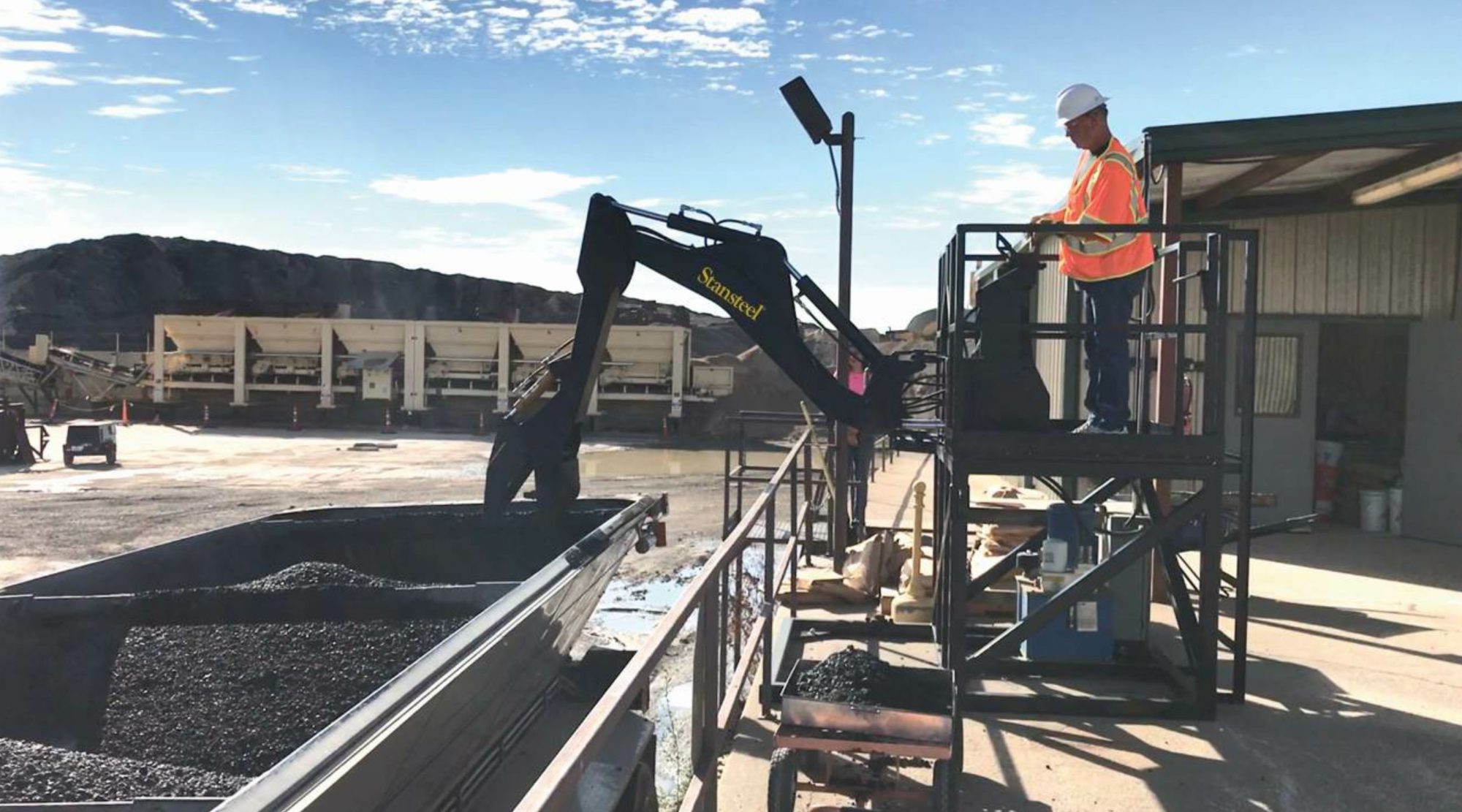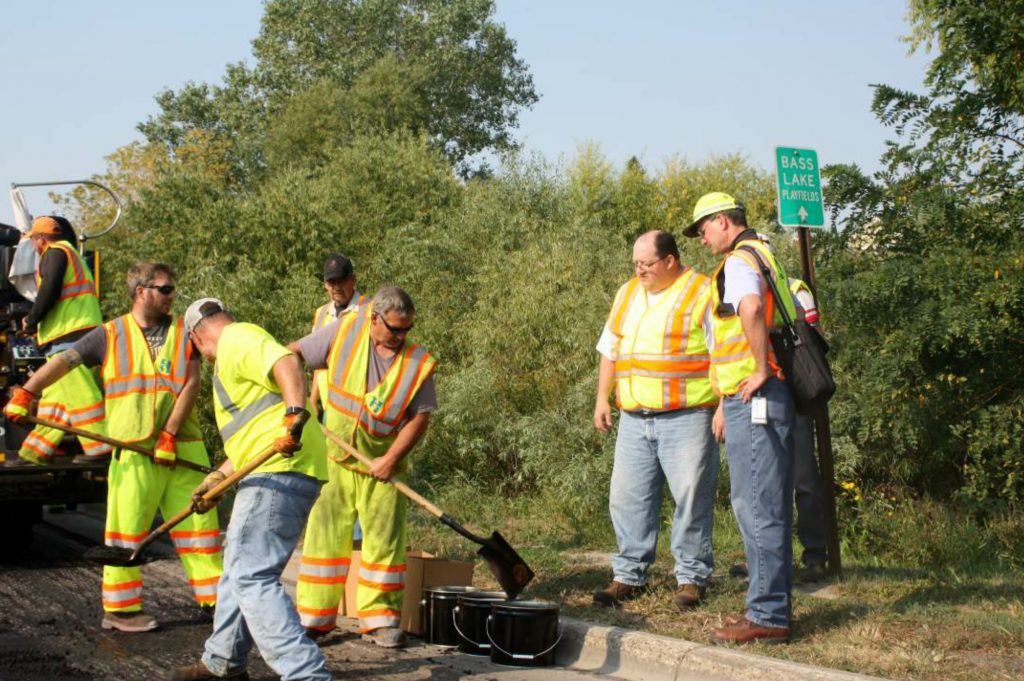Build the Test Section for Validation of Plant Produced Mixture
BY Ray Brown, PhD, P.E.

Asphalt mixture is designed in the laboratory to ensure satisfactory aggregate gradation, optimum asphalt content, and satisfactory mix volumetrics including air voids and voids in mineral aggregate (VMA). The aggregate and asphalt binder blending and mixing process in the lab is different than that at the asphalt plant so it is essential to validate that the mix produced during plant production is within the allowable tolerances of the designed mix.
The validation needs to be performed at the beginning of work before a large quantity of mix has been placed. This is normally performed as part of production, placement and compaction of a test section. The validation can also be performed at any time during construction that changes in the materials or processes occur or when test results are not satisfactory.
Alaska Uses Continuous, Full Coverage Testing to Detect Quality
Several terms are often used when referring to this test section. Terms that have been used when talking about validation of the mix quality include: test section, test strip and control section/strip. Generally, the term “control section/strip” is used in the evaluation of density and establishing roller patterns. “Test section” or “test strip” can be used interchangeably and this typically includes a control strip for evaluation of density. The test section may also include validation of the plant produced mix properties, and evaluation of construction methods including tack coat application, surface uniformity, joint construction, etc.

These two pictures show Minnesota Department of Transportation personnel and Hennepin County Department of Public Works personnel sampling 35 percent RAP content asphalt mix on County Route 61 in Maple Grove September 2017. While the typical practice is to retrieve a sample of asphalt mix from the back of the truck immediately after it loads at the silo, some agencies request gathering a sample from the paver just in front of the screed, which is happening here. That way, you get a representative specimen of what is definitely on the road.
Mix Properties to Evaluate
Several items need to be controlled during mix design and construction of asphalt mixes to ensure good performance. The mix design is developed in a lab prior to start of construction. Depending on the agency in charge of the project, there might be detailed spec requirements that the lab has to meet. For example, some agencies require that the lab be accredited by some organization such as AASHTO Materials Reference Laboratory (AMRL), state DOT, or other organizations involved in accreditation of labs. So be sure that the mix design is conducted in a lab that meets the requirements of the agency. Some steps include conducting a mix design for the asphalt mix to be produced and validating this mix design during mix production to ensure that mix properties are satisfactory.
Talk Test Terms
-
test section or test strip = may include validation of plant-produced mix properties and evaluation of construction methods, and typically includes a control strip
-
control section (control strip) = for evaluating density and establishing a good rolling pattern
The mix design consists of proportioning the aggregates and selecting the optimum asphalt content so that satisfactory air voids and VMA are obtained. In some cases, performance tests are conducted in the lab to help ensure desired mix performance is obtained but this varies a lot between agencies. It is essential to ensure that the plant produced mix meets the properties of the designed mix. Even though satisfactory properties are obtained with materials mixed in the lab, it may take some adjustments in the mix components to satisfactorily meet the mix design requirements during construction. A test section is often used to validate the mix properties with plant produced materials and to ensure that adequate density is obtained on the roadway. If the mix properties are not satisfactory during mix production for the test section, then adjustments of the mix components are required.
Comparison of Laboratory and Plant Produced Mix

The asphalt ignition test requires a calibration to correct for the aggregate weight loss during the test. Photo courtesy Bluegrass Testing
Conducting the mix design in the lab requires that the materials be proportioned by hand and mixed manually or with lab equipment to provide samples of mix for testing. Mixing in the lab does not create as much aggregate breakdown as occurs during plant proportioning and mixing. At the plant, the aggregate is abraded as a result of handling the materials in the stockpile, when feeding the material into the asphalt plant, and when the material flows through the plant components. It is not uncommon to produce up to 1 to 2 percent additional material passing the No. 200 sieve (dust) compared to that observed during the mix design process. Hence, the plant produced mix will generally have more dust than the mix designed in the lab. Also, the absorption of the asphalt binder into the aggregate will often be different in the plant than in the lab, especially for aggregates with relatively high absorption values.
Some mix designers correct for this lower dust content in the lab by adding dust during mix design to simulate the amount of breakdown that occurs during production. The additional dust is typically collected from the dust collector at the asphalt plant that will be used to produce the mix.
If additional dust is not added during mix design, the measured air voids and VMA will almost always be higher during the mix design than during plant production. Hence, the mix proportions will have to be adjusted during field production to produce satisfactory volumetrics. One of the problems that often occurs is the VMA during mix design is on the low side of requirements. If the VMA drops below the minimum limit during plant production, it may be difficult to meet the VMA requirements during production without significant changes in the mix proportions. In fact, low VMA is one of the biggest problems that asphalt producers face during production of asphalt mix. The test section, where a small amount of material is produced and placed, is an ideal procedure to evaluate the properties of the designed mix with minimal effect on production.
Mix Sampling from Plant Production
Most samples are obtained from loaded trucks, but this must be done very carefully. Some say to take a random sample out of the truck and others suggest that a representative sample be taken. Most agree that the preferred method is to take a representative sample from the truck. Most loaded trucks will have three cone-shaped peaks when the truck is loaded as recommended (front first, back second, and middle third). The technician should dig down below the surface in each of these three peaks and combine these samples into one to obtain a representative sample from the truck.
Theoretical Maximum Density

The laboratory bulk density is determined from the specified laboratory compaction procedure. Most now specify the Superpave gyratory compactor. Photo courtesy Bluegrass Testing, Louisville, Kentucky
One of the mix properties determined during mix design and one that must be determined in the test section is theoretical maximum density (TMD), according to ASTM D 2041 or AASHTO T 209. This is a very important property for controlling the quality of the produced and compacted mix. The TMD is compared to the laboratory bulk density (Figure 2) to determine air voids and compared to the in-place bulk density to determine percent compaction. The laboratory bulk density is determined from the specified laboratory compaction procedure. Most now specify the Superpave gyratory compactor (Figure 1) but there are several other methods including Marshall hammer and kneading compactor that can also be used if specified.
While it is not satisfactory to use the TMD determined during mix design to measure air voids during production or to determine in-place density during construction, this practice has sometimes been used. The TMD has to be determined from samples of plant produced mix that is representative of the mix being evaluated. One should never use the TMD determined during mix design for determining air voids or in-place compaction of plant produced mix.
Factors to Consider when Deciding Whether to Construct a Test Section
The agency does not always require the construction of a test section, but this is a good idea for the contractor whether or not it is required by the agency. There are times when a specific mix design has been produced through the same asphalt plant for previous jobs. In this case, there is a lot of data on the mix design and some tweaking of the mix has likely already occurred. Therefore, there is a lot of data on the properties of the specific mix design produced through the asphalt plant and hence there is little need to validate the lab properties of the mix. If the sources of aggregate change or another plant is used to produce the mix, then another test section will be required to help evaluate the mix properties.
At the startup of the plant, a significant amount of material must be fed through the plant before the gradation, asphalt content and mix temperature become stable enough for a representative sample of the mix can be obtained. Typically, at least one or two truckloads of mix must be produced before sampling is performed.
Most agencies specify that the test section be at least a few hundred feet long and sometimes as much as one day of production. Generally, it is desirable to keep the test section small enough so that if there is a problem in mix volumetrics or compaction of the asphalt mix, the time/cost for repair or rebuild, if necessary, is not too great. On the other hand, if the test section is too small, it is difficult to obtain a sample of mix representative of normal production and density of mix that will be representative of full-scale production.
The asphalt ignition test (AASHTO T308) is almost always used to measure asphalt content of plant produced mix. This test requires a calibration to correct for the aggregate weight loss during the test. This calibration can be performed during the plant production to ensure that the lab is set up to accurately measure the asphalt content as soon as full scale production begins.
At any time during the project, changes in aggregate sources or significant changes in the mix volumetrics may require that a new test section be constructed. While it is not desirable to have to stop full scale production and construct another test section, this may be the most cost effective procedure in some cases. The agency often provides spec requirements related to when additional test sections are required. If guidance is not provided, it is up to the contractor to determine the need for additional sections.
The volumetrics and other mix properties of the plant produced asphalt mix can be evaluated without having to place the mix in a test section. However, the in-place density is typically evaluated along with the mix properties so a test section is usually constructed.
Ray Brown, PhD, P.E., received his BS and MS degrees in civil engineering at Mississippi State University and his PhD from Texas A&M University. He retired after working for approximately 20 years for the U.S. Army Corps of Engineers and approximately 20 years for the National Center for Asphalt Technology (NCAT). He has honorary titles from Auburn University including Professor Emeritus of Civil Engineering and Director Emeritus of NCAT.
